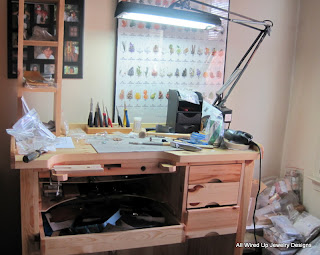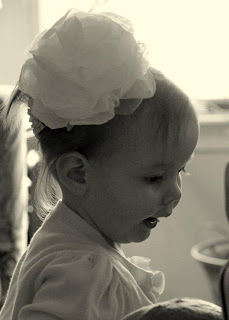It's been a very long time since I posted a blog - long over due! To re-start I think I am going to pull from my now 10 years of jewelry making and problems I have encountered along the way. Some of these are the making itself, some getting correct sizing from customers to insure a proper fit of a ring, cuff or bangle. Today- the simple but lovely cuff and how to properly put it on and take it off so it maintains it's original shape and fit.
What's not to love- the cuff comes in all shapes, widths and sizes and even different metals, bronze, copper, sterling and even gold. Behold - the simple hammered sterling cuff. This one is 1 inch wide and a reasonable but light 1 mm thick- a good everyday choice for work or casual day out. Now- How do you get that darn thing on and off a bunch of times and still keep it looking like this nice C shape and not some sort of twisted mess? The opening is only 1 inch wide- isn't my arm bigger than that?
Anyone can latch a bracelet and it fits right? Sure, but what about a cuff? Can you get it on and have it keep it's shape? Not hurt going on or coming off? This little trick will keep all your cuffs in shape, springy and looking great for a long time to come!
A cuff bracelet is one that does not close on the wrist but simply rests on the wrist with a gap or open area on the inside of the wrist. Unlike bangles (closed circles) cuff bracelets are worn low on the wrist bone rather than pushed up the forearm. Hold the cuff like a C in your opposite hand with the opening facing the arm your are going to wear it on. You want to find that soft area on the inside of your arm about 1 – 1.5 inches above your wrist- between the 2 bones in your wrist. Gently roll the end of the bracelet over the arm from the thumb side and just roll it over your arm. Let it slide down your arm to rest there. To remove the cuff, reverse the above and roll it right off your arm above your wrist!
Don't hook the cuff on the outside of the wrist and pull it over the top of the wrist. This actually pulls the cuff out of shape and will loosen any set stones in or on top of the cuff. In time, you could break or crack the cuff due to metal fatigue. Always start on the inside of your wrist. Cuffs usually only need to be adjusted once and not bent each time.
To order the correct size cuff - measure around your wrist where the cuff will be worn, not too tight, this is the inside circumference of the cuff including the opening. When ordering a cuff, look to see how wide the opening is and subtract that to get the length you need.
Cuffs are normally formed on an oval shape bracelet mandrel. This shape conforms to most wrists. If you have a round arm/wrist and not flat on top, be sure to discuss this with the maker of your cuff. Your artisan jeweler can allow a slightly longer length and shape the cuff to be more rounded on top and still conform to the sides of your wrist for a more comfortable fit.
Cuffs come flat, anticlastic with a concave center and curves that go up on the sides and synclastic with a dome that curves down to the wrist. Each of these basic styles has many variations, but all can be properly fitted and remain lovely for many years with proper care - AND putting them on and taking them off so they stay in their original shape.
My hope is next time you think about putting on that cuff, you'll remember this blog and smile because you know how to get that cuff on!
If you'd like to take a look at some of my cuffs- visit my shop on Etsy by clicking this link or copy and paste it into your browser- https://www.etsy.com/shop/PPennee
If you'd like to take a look at some of my cuffs- visit my shop on Etsy by clicking this link or copy and paste it into your browser- https://www.etsy.com/shop/PPennee












